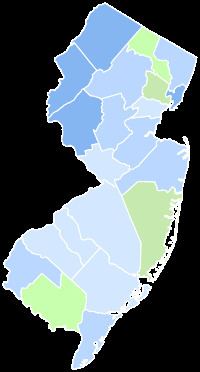0 0 41.2% 33.6% Start date November 5, 1912 Popular vote 178,289 Nominee Woodrow Wilson | 145,410 88,835 33.6% 20.5% Electoral vote 14 Running mate Thomas R. Marshall | |
 | ||
The 1912 United States presidential election in New Jersey took place on November 5, 1912. All contemporary 48 states, were part of the 1912 United States presidential election. New Jersey voters chose 14 electors to the Electoral College, which selected the President and Vice President.
New Jersey was won by the Democratic nominees, Governor Woodrow Wilson of New Jersey and his running mate Governor Thomas R. Marshall of Indiana. Wilson and Marshall defeated the Progressive Party nominees, former President Theodore Roosevelt of New York and his running mate Governor Hiram Johnson of California, and the Republican nominees, incumbent President William Howard Taft of Ohio and his running mate incumbent Vice President James S. Sherman of New York.
Wilson carried New Jersey with a bare plurality of 41.20% of the vote to Roosevelt's 33.60%, a victory margin of 7.60%. Taft came in third place with 20.53%.
Coming in a distant fourth was Socialist candidate Eugene V. Debs, who took 3.69%.
Like much of the Northeast, New Jersey in this era was a staunchly Republican state, having not given a majority of the vote to a Democratic presidential candidate since 1892. In his initial 1908 election campaign, Taft had carried New Jersey by a comfortable 57-39 margin. However in 1912, the Republican Party was split as former Republican President Theodore Roosevelt ran as a third party candidate against incumbent Republican President William Howard Taft, splitting the Republican voter base, and allowing Wilson to win many states with pluralities. Despite being the sitting Governor of New Jersey, Wilson only managed to earn 41% of the vote in his home state, but with the GOP split, this would prove to be enough to win New Jersey's electoral votes. Were Taft and Roosevelt voters united behind a single Republican candidate, the GOP would have received 54.13% of the vote in the state. (Four years later, in 1916, Wilson would lose his home state to the GOP in the midst of his otherwise successful re-election bid by a decisive 12-point margin in a head-to-head match-up, with Republican Charles Evans Hughes taking 54.40% to Wilson's 42.68%.)
On the county level map, Wilson carried 17 of the state's 21 counties, although 7 with pluralities between 40 and 50% of the vote, and 6 with pluralities of less than 40% of the vote. Wilson's only won majorities in urban Hudson County, along with the 3 rural counties in western North Jersey, Warren, Sussex, and Hunterdon, which had long been Democratic enclaves in an otherwise Republican state.
As Roosevelt and his Bull Moose Party finished a strong second ahead of incumbent Republican Taft in the state, the remaining four counties went to Roosevelt. Roosevelt won urban Essex County along with Ocean County with pluralities between 40 and 50% of the vote, while winning Passaic County and Cumberland County with pluralities of less than 40% of the vote.
Taft finished a weak third place in the state for an incumbent president and official Republican nominee, and failed to win a single county in New Jersey.
Although it was Wilson's home state and he had served as governor there, the results in 1912 made the state about 7% more Progressive/Republican than the national average.
